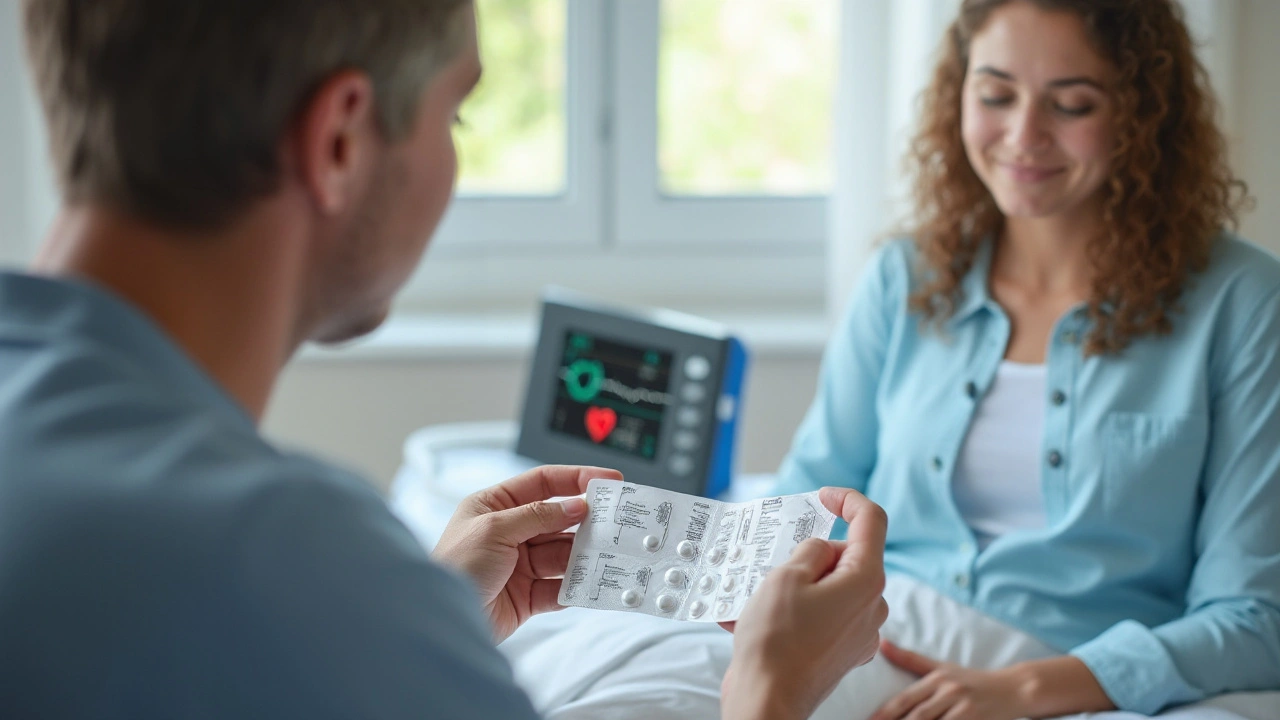Many people live with heart rhythm disorders, but what's fascinating is how medicine continues to advance, offering hope and solutions. Among these medical marvels is Diltiazem HCL, a compound that has been making a significant impact on managing supraventricular tachycardia (SVT).
SVT can strike at any moment, leaving individuals with an uncomfortably fast heartbeat that disrupts everyday life. Thankfully, Diltiazem HCL provides a pathway back to normalcy by helping to control these irregular rhythms.
In exploring its uses, one finds a medication that not only stabilizes the heart but also opens doors to living more freely without the specter of an unexpected tachycardia attack. It's not just about taking a pill; it's about embracing a treatment that aligns with one's health journey.
With the right knowledge and adaptability, Diltiazem HCL can be a game-changer in your heart health strategy.
- Understanding Supraventricular Tachycardia
- How Diltiazem HCL Works
- Benefits and Usage Tips
- Potential Side Effects and Lifestyle Adjustments
Understanding Supraventricular Tachycardia
Supraventricular tachycardia, or SVT, is a term that describes a broad group of arrhythmias originating from above the heart's ventricles. It's a condition characterized by an abnormally fast heartbeat, often exceeding 100 beats per minute. These episodes usually start and end suddenly, and they can cause the heart to race unexpectedly, leading to discomfort in daily life. While the origins of SVT might seem mysterious to patients, the causes are generally found within the heart's electrical conduction system.
SVT occurs due to an issue in the electrical signals that control heartbeats, causing them to fire abnormally. The condition can manifest in various forms, including atrioventricular reentrant tachycardia (AVRT), atrioventricular nodal reentrant tachycardia (AVNRT), and atrial tachycardia. Among these, AVNRT is the most common, accounting for approximately 60% of cases. This particular form of SVT is more prevalent in adults, especially in women, highlighting the importance of gender-specific research and tailored treatment options. Supraventricular Tachycardia, while not generally life-threatening, can lead to complications if untreated, such as heart failure or fainting, particularly in those with other heart conditions.
The causes of SVT are varied, ranging from innocuous triggers like caffeine and stress to more concerning issues such as congenital heart defects. Those with pre-existing heart conditions or those experiencing an imbalance in electrolytes are also at heightened risk. Understanding these triggers is key to managing the condition effectively. Cardiologists often advise patients to maintain a diary to note down the triggers and symptoms they experience. Such diligence can pave the way for a more tailored treatment approach by identifying specific patterns or episodes associated with the arrhythmia.
"Patients dealing with supraventricular tachycardia should focus on lifestyle modifications alongside medical interventions. Avoiding triggers and managing stress can substantially improve quality of life," notes Dr. Alice Peterson of the Mayo Clinic.
Diagnosing SVT involves several steps, beginning with a thorough examination and taking a detailed patient history. Healthcare professionals may employ various diagnostic tools such as electrocardiograms (ECG), Holter monitors, or exercise stress tests to capture the arrhythmia and understand its nature. ECGs are particularly crucial as they record the heart's electrical activity, pinpointing where the abnormal rhythms originate. For instance, an SVT episode captured during an ECG can reveal crucial details about its type and potential triggers, enabling a more effective treatment strategy.
Data from the American Heart Association suggests that as many as 2.3 per 1,000 people experience SVT, though many cases go unrecorded due to their sporadic nature. With SVT episodes often being brief, diagnosing and understanding the full impact of the condition can be challenging. Yet, these statistics underline the importance of awareness and regular monitoring. Advancements in wearable technology now offer new avenues for patients to keep track of their heart rhythms in real-time, providing invaluable data during consultations.
Overall, comprehending supraventricular tachycardia involves a partnership between the patient and healthcare providers, focusing on identifying symptoms, understanding triggers, and selecting the most appropriate interventions. This partnership ensures that individuals not only manage SVT more effectively but also continue to lead fulfilling lives despite the condition’s presence. Addressing SVT with both medical and non-medical strategies can create a balanced approach that fosters long-term heart health.

How Diltiazem HCL Works
Diltiazem HCL belongs to a class of medications known as calcium channel blockers. Its main role lies in managing cardiovascular conditions, especially Supraventricular Tachycardia (SVT). When your heart is racing uncontrollably, it’s a signal that something in the electrical impulses isn't lining up correctly. This is where Diltiazem HCL steps in, effectively acting as a bouncer that controls the flow of calcium ions in the heart muscle cells. Calcium plays a crucial role in muscle contraction, including the heart muscle, and by moderating its influx, Diltiazem HCL can reduce the force of the heart’s contractions, ensuring that the heart does not respond too vigorously to electrical signals.
What makes Diltiazem HCL particularly valuable is its dual action. It not only slows down the heart rate but also helps in dilating blood vessels. This dual mechanism significantly reduces the heart’s workload, which can be particularly beneficial to those suffering from SVT. The dilation of blood vessels also helps lower blood pressure, providing an added benefit for those who might be dealing with hypertension alongside their irregular heartbeats. By doing so, it effectively creates a calmer, more stable cardiovascular environment where the heart can function more efficiently.
Within the Heart's Electrical System
The heart consists of an intricate network of tissue responsible for generating and conducting electrical impulses. This system dictates how and when the heart beats. Supraventricular Tachycardia primarily affects the atria or the upper chambers of the heart. During an episode, the heart may miss its scheduled beats, leading to chaotic and rapid contractions. By targeting the L-type calcium channels, Diltiazem HCL manages to slow down the electrical conduction through the Atrioventricular node, a critical component in the heart’s electrical relay."The significant impact of calcium channel blockers like Diltiazem HCL on arrhythmia is well-documented and supported by extensive clinical research," mentions cardiologist Dr. Emily Tan. Her insights highlight the importance of Diltiazem HCL in moderating heart rhythms effectively.For individuals who experience recurring SVT episodes, understanding the operational nuances of their medication can encourage proper adherence and adjustments in lifestyle to maximize its benefits.
To visualize the impact of Diltiazem HCL, consider a study indicating a marked decrease in SVT episodes among users. Notably, approximately 75% noticed a significant reduction in palpitations, as reported over an extensive period of time. This data underscores the medication's capability to transform lives that are frequently interrupted by rapid heartbeats and associated discomfort.
The pathway it traverses in your body is precise yet sophisticated, helping stabilize what is essentially an electrical storm within the heart. Patients often report relief after a short period of consistent use, underlining how Diltiazem HCL integrates into their daily health regimen seamlessly. This remarkable ability to optimize heart function with significant impact explains why it remains a mainstay in treating conditions like SVT.

Benefits and Usage Tips
The usage of Diltiazem HCL has become quite prevalent among those dealing with Supraventricular Tachycardia (SVT), but understanding why this medication is beneficial can help demystify any uncertainties. For starters, Diltiazem HCL works as a calcium channel blocker. By slowing down the movement of calcium into the cells of the heart, it effectively reduces heart rate and helps to maintain regular rhythms. This mechanism not only assists in relieving rapid heartbeats but also alleviates the strain that these episodes can impose on the heart muscle over time.
One compelling fact about Diltiazem is its versatility in form and dosage. Patients may find it comforting to know that this medication is available in both oral and intravenous forms, providing healthcare providers with flexibility in acute situations versus long-term management. Oral forms are particularly preferred for ongoing treatment, offering extended-release options that enhance convenience and adherence to the treatment plan.
Besides its pharmaceutical functions, Diltiazem HCL comes with practical usage tips that can enhance its efficacy. It’s essential to ingrain the habit of regular intake at the same time each day to synchronize its action with your body's rhythm. Missing doses is not recommended, as it could result in a possible recurrence of SVT symptoms. Patients are also advised to be mindful of certain lifestyle factors, such as caffeine or stress levels, which could provoke episodes of increased heart rates.
One might wonder about the clinical backing for Diltiazem's use in SVT management. A study published in the Journal of Clinical Therapeutics emphasized that this medication significantly improved patient quality of life by reducing hospital visits and enhancing symptom control. This finding reiterates the importance of considering Diltiazem HCL as a part of a comprehensive treatment strategy.
When incorporating Diltiazem HCL into your care plan, it’s always valuable to monitor blood pressure and heart rate regularly. Maintaining a journal of readings can offer insights into how well the medication is working and help your healthcare provider make necessary adjustments. Always consult your doctor before making any changes to your regimen or addressing potential side effects you might face.
"By mitigating SVT symptoms, Diltiazem HCL shifts the control back to patients, offering not just physical relief but enhanced peace of mind," remarks Dr. Susan Channing, a leading cardiologist.Understanding these dynamics offers individuals a clearer view of how this medication supports heart health holistically, providing a cornerstone in tackling one of the most common heart rhythm issues faced today.

Potential Side Effects and Lifestyle Adjustments
When it comes to managing heart rhythm disorders with Diltiazem HCL, it's essential to recognize that like any medication, it brings along a spectrum of potential side effects. These can range from mild to more pronounced, depending on individual reactions. Common experiences might include dizziness, fatigue, or even digestive discomfort, all of which are usually manageable with some adjustments. A deeper dive into these effects reveals that dizziness often stems from the medication's impact on lowering blood pressure, which is inherently a part of its function in treating Supraventricular Tachycardia. Adjusting slowly when standing from sitting or lying down can reduce sudden dizziness events, allowing the body to acclimate gradual changes in positioning.
Fatigue, while sometimes puzzling, reflects the body's mirror image response to the energy demands once placed upon it by rapid heart rhythms. Resting adequately, especially in the initial phases of medication, can help balance the body's newfound serene rhythm with day-to-day vigor. Digestive issues, on another note, call for dietary mindfulness. Small, frequent meals instead of larger ones, paired with ample hydration, may ease the stomach while on this heart rhythm journey. Therein lies a fascinating balance, one where minor adjustments can provide major comfort. A study published by the American Heart Association states, "Medications like Diltiazem HCL have been transformative in managing cardiac disorders, but they demand a personalized approach to care for optimal benefits."
Adapting Lifestyle for Better Outcomes
Embracing lifestyle changes doesn’t need to be overwhelming; it's about gradual improvements that align with health goals. Physical activity serves as a cornerstone for supporting cardiovascular treatments like this. Engaging in moderate activities, such as walking or swimming, not only strengthens the heart but also enhances mood and energy levels. Yoga and meditation can further support mental well-being, alleviating stress that can negatively impact heart health. Nutrition should not be overlooked either. Consuming a heart-healthy diet rich in omega-3 fatty acids, fruits, and vegetables isn't just about avoiding certain foods but embracing a nourishing array of delicious and satisfying meals. Limiting caffeine and alcohol can prevent any unnecessary stimulation of the heart, providing a calmer background for the medication's work.
Finally, while social engagement and support systems fortify emotional and mental health, regular checkups with healthcare providers ensure that this balance is maintained. They can offer valuable insights and rapid intervention should an unanticipated side effect arise. By adopting these efforts not as constraints but enhancements to lifestyle, the journey with Diltiazem HCL can become not only one of compliance but of thriving wellness.


Comments (9)